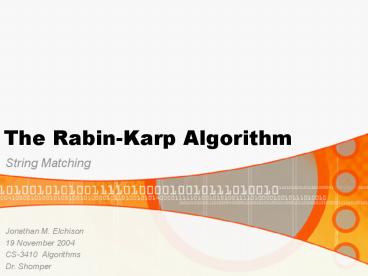The Rabin-Karp Algorithm - PowerPoint PPT Presentation
1 / 11
Title:
The Rabin-Karp Algorithm
Description:
n size of input string. m size of pattern to be matched. O( (n-m 1)m ) T( n2 ) if m ... 'Radix-d digits' How it works. Hash pattern P into a numeric value ... – PowerPoint PPT presentation
Number of Views:2021
Avg rating:3.0/5.0
Title: The Rabin-Karp Algorithm
1
The Rabin-Karp Algorithm
- String Matching
Jonathan M. Elchison 19 November 2004 CS-3410
Algorithms Dr. Shomper
2
Background
- String matching
- Naïve method
- n size of input string
- m size of pattern to be matched
- O( (n-m1)m )
- T( n2 ) if m floor( n/2 )
- We can do better
3
How it works
- Consider a hashing scheme
- Each symbol in alphabet S can be represented by
an ordinal value 0, 1, 2, ..., d - S d
- Radix-d digits
4
How it works
- Hash pattern P into a numeric value
- Let a string be represented by the sum of these
digits - Horners rule ( 30.1)
- Example
- A, B, C, ..., Z ? 0, 1, 2, ..., 26
- BAN ? 1 0 13 14
- CARD ? 2 0 17 3 22
5
Upper limits
- Problem
- For long patterns, or for large alphabets, the
number representing a given string may be too
large to be practical - Solution
- Use MOD operation
- When MOD q, values will be lt q
- Example
- BAN 1 0 13 14
- 14 mod 13 1
- BAN ? 1
- CARD 2 0 17 3 22
- 22 mod 13 9
- CARD ? 9
6
Searching
7
Spurious Hits
- Question
- Does a hash value match mean that the patterns
match? - Answer
- No these are called spurious hits
- Possible cases
- MOD operation interfered with uniqueness of hash
values - 14 mod 13 1
- 27 mod 13 1
- MOD value q is usually chosen as a prime such
that 10q just fits within 1 computer word - Information is lost in generalization (addition)
- BAN ? 1 0 13 14
- CAM ? 2 0 12 14
8
Code
- RABIN-KARP-MATCHER( T, P, d, q )
- n ? length T
- m ? length P
- h ? dm-1 mod q
- p ? 0
- t0 ? 0
- for i ? 1 to m ? Preprocessing
- do p ? ( dp P i ) mod q
- t0 ? ( dt0 T i ) mod q
- for s ? 0 to n m ? Matching
- do if p ts
- then if P 1..m T s1 .. sm
- then print Pattern occurs with shift s
- if s lt n m
- then ts1 ? ( d ( ts T s 1 h )
T s m 1 ) mod q
9
Performance
- Preprocessing (determining each pattern hash)
- T( m )
- Worst case running time
- T( (n-m1)m )
- No better than naïve method
- Expected case
- If we assume the number of hits is constant
compared to n, we expect O( n ) - Only pattern-match hits not all shifts
10
Demonstration
- http//www-igm.univ-mlv.fr/lecroq/string/node5.ht
ml
11
The Rabin-Karp Algorithm
- Sources
- Cormen, Thomas S., et al. Introduction to
Algorithms. 2nd ed. Boston MIT Press, 2001. - Karp-Rabin algorithm. 15 Jan 1997.
lthttp//www-igm.univ-mlv.fr/lecroq/string/node5.h
tmlgt. - Shomper, Keith. Rabin-Karp Animation. E-mail
to Jonathan Elchison. 12 Nov 2004.
- String Matching
Jonathan M. Elchison 19 November 2004 CS-3410
Algorithms Dr. Shomper































